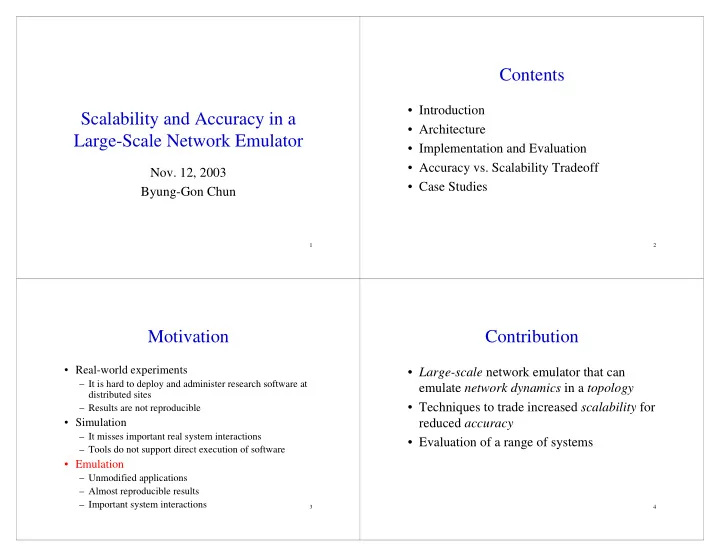

Contents • Introduction Scalability and Accuracy in a • Architecture Large-Scale Network Emulator • Implementation and Evaluation • Accuracy vs. Scalability Tradeoff Nov. 12, 2003 • Case Studies Byung-Gon Chun 1 2 Motivation Contribution • Real-world experiments • Large-scale network emulator that can – It is hard to deploy and administer research software at emulate network dynamics in a topology distributed sites • Techniques to trade increased scalability for – Results are not reproducible • Simulation reduced accuracy – It misses important real system interactions • Evaluation of a range of systems – Tools do not support direct execution of software • Emulation – Unmodified applications – Almost reproducible results – Important system interactions 3 4
Architecture ModelNet Phases EN • Generate a network VN topology CR • Source: Internet Pipe traces, BGP dumps, Synthetic topology • Target: GML 5 6 ModelNet Phases ModelNet Phases • Source: GML • Map components of the distilled topology • Target: Pipe topology to core nodes • Optionally, simplify • Minimize the the network bandwidth demands • Greedy algorithm 7 8
ModelNet Phases Core Router • Routing table • Assign VNs to ENs – Memory vs Computation • Multiplex VNs Tradeoff • Descriptors referencing • Bind an EN to a CR buffered packets • Generate • Schedule descriptors on configuration scripts pipes using a heap • Admission control of • Install pipes and packets injected routing tables to CRs • Multihop and multi- • Set up IP addr for VNs core 9 10 Discussion Evaluation of Implementation • Accuracy - 1ms worst-case error per hop • Resource isolation • Capacity – UDP flows – 120000 packets/s with 1 hop • Routing protocol – 90000 packets/s with 8 hops – Assumes shortest path routing and • Core crossing instantaneous repair of node and link failures – For 4 node configuration and 2 hop paths, 0% cross-core traffic – 462.5Kpkt/s – Routing protocol dynamics (update 100% cross-core traffic – 155.8Kpkt/s propagation) – Depends on target topology and application – Flexibility to inject routing algorithms communication patterns • Policy-based routing 11 12
Accuracy vs. Scalability Accuracy vs. Scalability Tradeoffs Tradeoffs • Continuum balancing accuracy and cost • Distillation – Reduce the diameter of the network – Hop-by-hop – End-to-end: bottleneck bandwidth, latency, loss rate – Walk-in and walk-out(?) – Other approaches? – Flow-based [Narses] –– No wall-clock time or network size? – Tradeoffs? 13 14 Accuracy vs. Scalability Case Studies Tradeoffs • VN multiplexing • 10000 node gnutella network emulation – Howto? Mapping of multiple VNs to a EN • CFS, Replicated web services, Adaptive overlays, – Context switch, scheduling and resource contention Ad hoc networking(?) – Concurrency model • CFS: reproduce the published experimental results – Number of processes ↑ → Aggregate thp. ↓ • Replicated web services: support for realistic • Network characteristics Internet topologies and emulation of contention of – Howto? Synthetic background cross traffic in CRs shared pipes – Do not capture all packet dynamics (TCP slow start, • Adaptive overlays: subject systems to dynamically bursty traffic) changing network conditions – Network change - recompute shortest paths • Fault injection like partitions, bandwidth change 15 16
Case Studies Case Studies 17 18 Case Studies Discussion? 19 20
Recommend
More recommend